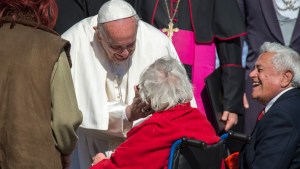As around the world, more governments discuss and promote euthanasia and assisted suicide, the Vatican body that deals with life issues published a “Small lexicon on end-of-life” on June 26, 2024, to help people enter the debate and understand one another better.
The Vatican’s Pontifical Academy for Life’s short book contains 22 definitions, spanning from “palliative care,” to “euthanasia,” to “pain.”
Although the lexicon is only available in Italian at the moment, and thus focuses on the Italian legal and political discussions, the Pontifical Academy for Life hopes to create versions of this book in other languages that can be rooted in the local contexts and their debates.
The President of the Academy, Archbishop Vincenzo Paglia, spoke to Aleteia about the importance of detangling these complex topics in addressing such a delicate and sensitive period such as the end of one’s life.
How did the idea of creating this Lexicon on End-of-Life come about?
Archbishop Paglia: Public debate on end-of-life issues is not new. And yet, in recent years, it has strengthened in intensity and broadened in scope, including geography. It is talked about frequently in media outlets and in social media, starting with both personal situations that cause a stir and legislative proposals that divide parliaments.
However, public opinion is not always adequately involved. And often the debate becomes merely ideological. It often happens, for example, that the terms of the debate are misunderstood. The same words are sometimes used with different meanings, making it difficult to understand each other not only because of the difference in positions, but also because of the complexity of the terms.
Hence the idea of a “lexicon” – or rather a small dictionary (there are just 22 entries) – which would explain the terms that pertain to the complex and articulated topic of the end of one’s life.
The aim of this small lexicon is to help untangle the jungle of delicate and difficult topics, to first of all aid people to understand, and also to avoid misunderstandings due to a lack of comprehension of certain terms. I hope it can help everyone to deal – not only at the legislative level – with this last stretch of human life in a calm and engaging way … so that the passage of death can truly be treated with dignity.
Why do you think it is important that it was the Pontifical Academy for Life that created such a book ?
Archbishop Paglia: The Pontifical Academy for Life, of which I am president, has as one of its objectives to delve into the great questions that affect the different moments of human life. The intent is to grasp their meaning and to help each person choose responsibly when the time comes to make decisions […].
This is true on both a personal and societal level. The current Lexicon responds in particular to the Italian situation, although these issues are being paid attention to in many other countries and not only in Europe.
In Italy we have a Constitutional Court ruling (No. 242/2019) decriminalizing aid to suicide under certain precise conditions. At the same time, the Court called on Parliament to legislate. A bill was passed in the Chamber of Deputies in 2022, but the process stalled in the Senate and the matter was not taken up again. Thus those who find themselves in the conditions set by the 2019 ruling have to turn to the courts, adding to their suffering the weight of a court trial. Moreover, the procedures are uneven, depending on local interpretations from time to time. There is a disparity in treatment that is contrary to the principles of justice.
In addition, as an Academy, we have tried to place the questions of dying (and suffering) in a broader framework, including on a cultural and existential level. It is within this framework that we need to situate the questions that arise at the end of one’s life.
This is why we have also worked for the knowledge and practice of palliative care, on which Italy has an excellent law (No. 38/2010). Progress is being made in its implementation, but unfortunately still too slow and its application is still patchy. There is a need to dispel the misconception that the only way to reduce pain and suffering is to take one’s life.
What criteria did you use to choose these 22 words? Were there others you considered but did not include at the end?
Archbishop Paglia: On the one hand, we identified the most frequently used terms in the public debate, so that people can consult the lexicon for reading newspapers, following discussions, and talking to doctors, for example when one of our family members is in a critical situation. So there are words such as “shared care planning,” “proportionality of treatment” and “intensive neonatal and pediatric care.”
On the other hand, we looked at words that indicate the context of relationships, such as “accompanying,” “pain” and “suffering.” When appropriate, we also tried to articulate the relationship between ethics and law, showing the circularity that connects them without identifying them.
You mention in the introduction that end-of-life issues are now being debated all over the world. Do you plan to translate your book into other languages? Which ones and when?
Archbishop Paglia: We hope to also produce other “lexicons” designed for different languages. However, the difference in social and cultural contexts will require not only a translation, but a real transposition, taking into account different situations and sensitivities. This way the text can work itself into the cultural, legislative, and political contexts of the single country.
Has your book been sent to members of the Church in Italy? How do you think your lexicon can be used by Catholics to deal with these issues?
Archbishop Paglia: Yes, the volume has been sent to all Italian bishops to provide them with a reference tool. We hope it will be useful. The media usually simplifies the Church’s position to a series of “no’s.” Instead, the Church affirms “yes”: yes to life, certainly, but also yes to an attitude of care that privileges the relationship of accompaniment and care, avoiding all forms of abandonment and encouragement to suppress life.
It is also important for bishops and all pastoral workers in the field of health to distinguish between the situations in which it is legitimate (also according to what Law No. 219/2017 states) to suspend treatments, from those interventions that tend instead to take life.
What would you like to see done at the parish and local level to help the Church address the “culture of death” and “throw-away culture,” particularly society’s push for euthanasia?
Archbishop Paglia: First of all, it is necessary to learn to live in an attitude of caring and mutual solidarity, which allows for valid and satisfying relationships. The ability to go through pain and suffering is not just a medical or pharmacological fact, but rather a cultural and social enterprise. The prevention of suicide and euthanasia starts from afar.
Moreover, there is a need to better frame what the purposes and limitations of medicine are. Palliative care also points to a new cultural attitude that emphasizes the need to always care for the other, even when healing cannot be achieved. Ultimately, it is about coming to terms with a limit, and working out an understanding of it that sees it as part of the human condition and not as an enemy to be fled or defeated.
In the introduction you define some key guiding “coordinates” for the book, such as life and freedom, from a Christian perspective. You also talk about the importance of dialogue with those who have a different moral language. How do you think this lexicon can help people who do not share the same moral language of the Church to understand it better?
Archbishop Paglia: So far, the initial reception we have received has been positive. Many have told me, including from the lay sphere, that they have benefited from reading this text. In this sense, a first goal has already been achieved! There are certain themes and questions that are universal, that pertain to what I call the “common man.” It is essential that there is a shared research on this; answers need to be found together.
In the introduction you specify that this lexicon also serves to reduce misunderstandings regarding “statements that are sometimes attributed to believers and that, not infrequently, are instead the result of commonplace ideas that have not been adequately scrutinized.” What do you mean by this phrase?
Archbishop Paglia: I have participated in many debates in recent years, both on television and at conferences. I have verified that the Church’s position is often presented in a “caricatured” way. It seems [according to this outlook] that the Church wants to impose a view […] that celebrates suffering as a value in itself.
Instead, in the believer’s understanding, life is entrusted to us, but not to be used arbitrarily: The exercise of freedom is not done by putting only oneself at the center, but always taking others into account as well. To quote the gospel, “No one has greater love than this,to lay down one’s life for one’s friends.” (Jn 15:13).
In this sense, for us Christians, death is a penultimate reality. We know that after death there will be a different, eternal life, which we already experience now whenever we access this logic of giving and gratuitousness. It is the Christian Hope. We need to rediscover these profound truths, and we need to preach them more often!



